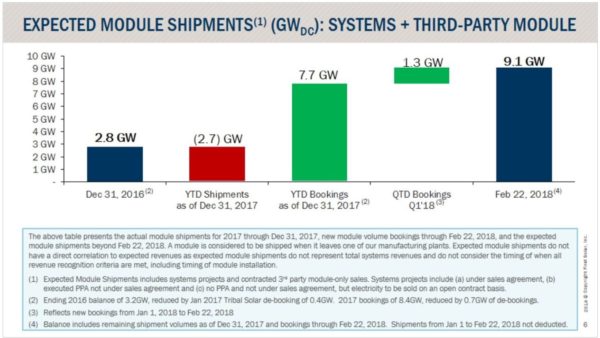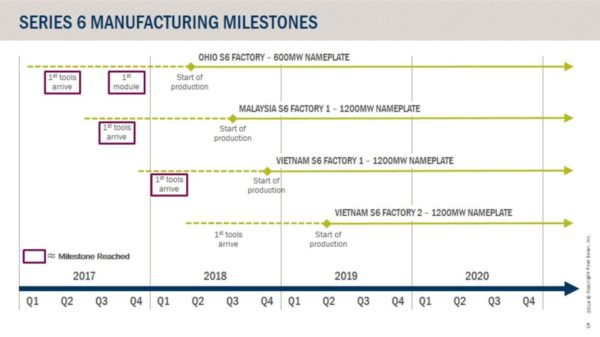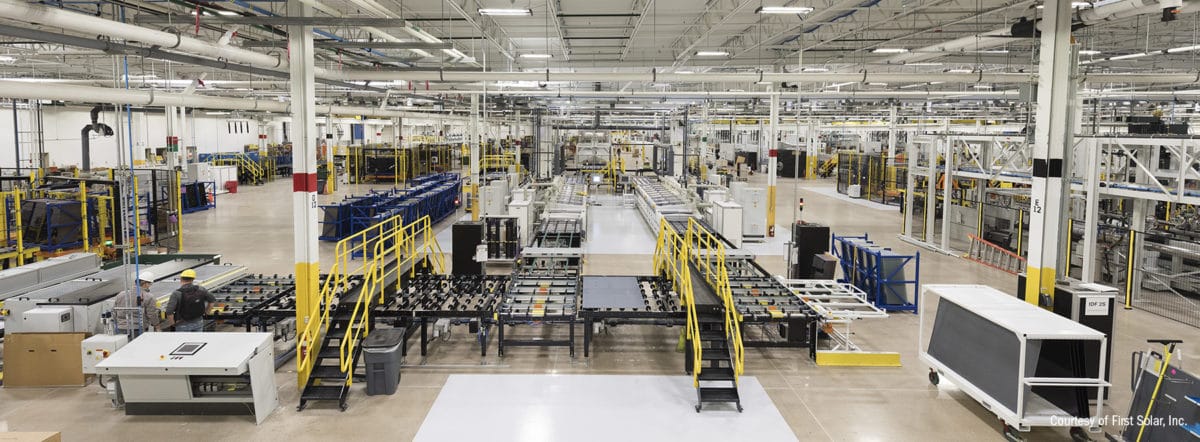First Solar reported another quarter of solid results in Q4. Even with a $408 million financial hit due to tax reform, the company remains in good shape as it transitions to Series 6 production and raised its 2018 guidance as it plans to bring back some Series 4 capacity to meet its 2+ year backlog of demand.

The company came into 2017 with a 2.8 GW module backlog, which it delivered on during the year. However, during 2017 First Solar booked an additional 7.7 GW of PV modules. And so far in Q1 2018 – through February 22 – it is reporting another 1.3 GW in bookings, bringing the total to a stunning 9.1 GW-DC.
First Solar supplied additional details about the transition to Series 6 during its results call. After producing its first S6 module in November, the company expects to start mass production of its Series 6 in Ohio during Q2.

First Solar also reports that more than 90% of the front-end tools for Series 6 production have been installed at its factory in Kulim, Malaysia and expects 1.2 GW of annual capacity to come online in Q3 2018 at the plant. The first coater has arrived at the company’s Vietnam factory, and the company expects to begin S6 commercial production during Q4 2018 in Vietnam and during Q2 2019 at its second Vietnam factory.
At that point, First Solar will have 4.2 GW/year of Series 6 capacity. Under this plan, First Solar is sold out of modules through the first half of 2020 and possibly into 2021.
First Solar’s financials were not as promising. The company has reported a $408 million expense due to changes from the recent tax reform, including the BEAT provision. This is more than the $339 million that it brought in during the quarter, and even before this tax expense First Solar reported a -10% operating margin, in part due to $20 million in ramping costs, and after the tax expense saw a loss of $432 million during Q4.
However, First Solar brought in cash during the quarter and is currently sitting on $3 billion in cash and marketable securities, so it can afford to have a few quarters of losses.
The price per watt of the Series 4 PV module fell 14% over 2017. Concurrently, the PV module gained 3% efficiency in 2017. The fleetwide gain was an absolute value of 0.5%, from 16.4 to 16.9%.

The company highlighted commercial and utility PPAs as a future growth opportunity – referencing an unnamed 180 MW project for a group aiming toward 100% renewable energy. Most of the company’s bookings are still in the USA – though a 100 MW-AC Australian project pipeline was highlighted.
The company also highlighted electricity utility relationships – specifically an Arizona project that included energy storage, and a Georgia project of 200 MW. The Arizona project was called out due to its load shifting nature – allowing for solar power to be used during the early evening peak demand period.
First Solar ended the call on a positive note communicating that being sold out, potentially already into 2021, was uncharted waters for them. Analysts asked if there was a possibility of squeezing more volume out of current facilities to meet this demand. It was suggested, at most, a few hundred MW could be gained via U.S. facilities.
This content is protected by copyright and may not be reused. If you want to cooperate with us and would like to reuse some of our content, please contact: editors@pv-magazine.com.









By submitting this form you agree to pv magazine using your data for the purposes of publishing your comment.
Your personal data will only be disclosed or otherwise transmitted to third parties for the purposes of spam filtering or if this is necessary for technical maintenance of the website. Any other transfer to third parties will not take place unless this is justified on the basis of applicable data protection regulations or if pv magazine is legally obliged to do so.
You may revoke this consent at any time with effect for the future, in which case your personal data will be deleted immediately. Otherwise, your data will be deleted if pv magazine has processed your request or the purpose of data storage is fulfilled.
Further information on data privacy can be found in our Data Protection Policy.